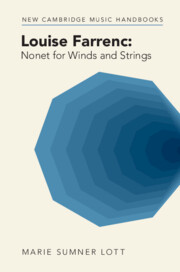Book contents
- Louise Farrenc: Nonet for Winds and Strings
- New Cambridge Music Handbooks
- Louise Farrenc: Nonet for Winds and Strings
- Copyright page
- Contents
- Figures
- Tables
- Musical Examples
- Introduction to the Life and Career of Louise Farrenc
- 1 Cultivating an Audience for Chamber Music in 1840s Paris
- 2 Dialogue and Play in the Nonet
- 3 Reception and Legacy of Farrenc’s Nonet
- Bibliography
- Index
Introduction to the Life and Career of Louise Farrenc
Published online by Cambridge University Press: 23 October 2025
- Louise Farrenc: Nonet for Winds and Strings
- New Cambridge Music Handbooks
- Louise Farrenc: Nonet for Winds and Strings
- Copyright page
- Contents
- Figures
- Tables
- Musical Examples
- Introduction to the Life and Career of Louise Farrenc
- 1 Cultivating an Audience for Chamber Music in 1840s Paris
- 2 Dialogue and Play in the Nonet
- 3 Reception and Legacy of Farrenc’s Nonet
- Bibliography
- Index
Summary
Louise Farrenc grew up in Paris during the Revolutionary period that saw the rise and fall of Napoleon Bonaparte and of different monarchies in France. These political changes impacted the Parisian musical scene and influenced Farrenc’s career and that of her friends and colleagues. Farrenc began her career as a virtuoso pianist-composer writing popular works like sets of variations on opera melodies and folksongs, but at the end of the 1830s, she changed her musical path. In the 1840s, like many composers in Central Europe at the time, she abandoned the virtuoso music of her youth to write chamber music with and without piano as well as three symphonies. She became known as a composer of serious music, an upholder of “German” traditions in France, and critics wrote about her compositions as representing the best new music of France. Her Nonet for Winds and Strings provides a culmination of the work she had done up to that point as a composer and performer devoted to finding a “middle way” between the Classical and Romantic traditions.
Keywords
Information
- Type
- Chapter
- Information
- Louise Farrenc: Nonet for Winds and Strings , pp. 1 - 22Publisher: Cambridge University PressPrint publication year: 2025
Accessibility standard: Inaccessible, or known limited accessibility
Why this information is here
This section outlines the accessibility features of this content - including support for screen readers, full keyboard navigation and high-contrast display options. This may not be relevant for you.Accessibility Information
Content Navigation
Allows you to navigate directly to chapters, sections, or non‐text items through a linked table of contents, reducing the need for extensive scrolling.
Provides an interactive index, letting you go straight to where a term or subject appears in the text without manual searching.
Reading Order & Textual Equivalents
You will encounter all content (including footnotes, captions, etc.) in a clear, sequential flow, making it easier to follow with assistive tools like screen readers.
You get concise descriptions (for images, charts, or media clips), ensuring you do not miss crucial information when visual or audio elements are not accessible.
Visual Accessibility
You will still understand key ideas or prompts without relying solely on colour, which is especially helpful if you have colour vision deficiencies.
Structural and Technical Features
You gain clarity from ARIA (Accessible Rich Internet Applications) roles and attributes, as they help assistive technologies interpret how each part of the content functions.
